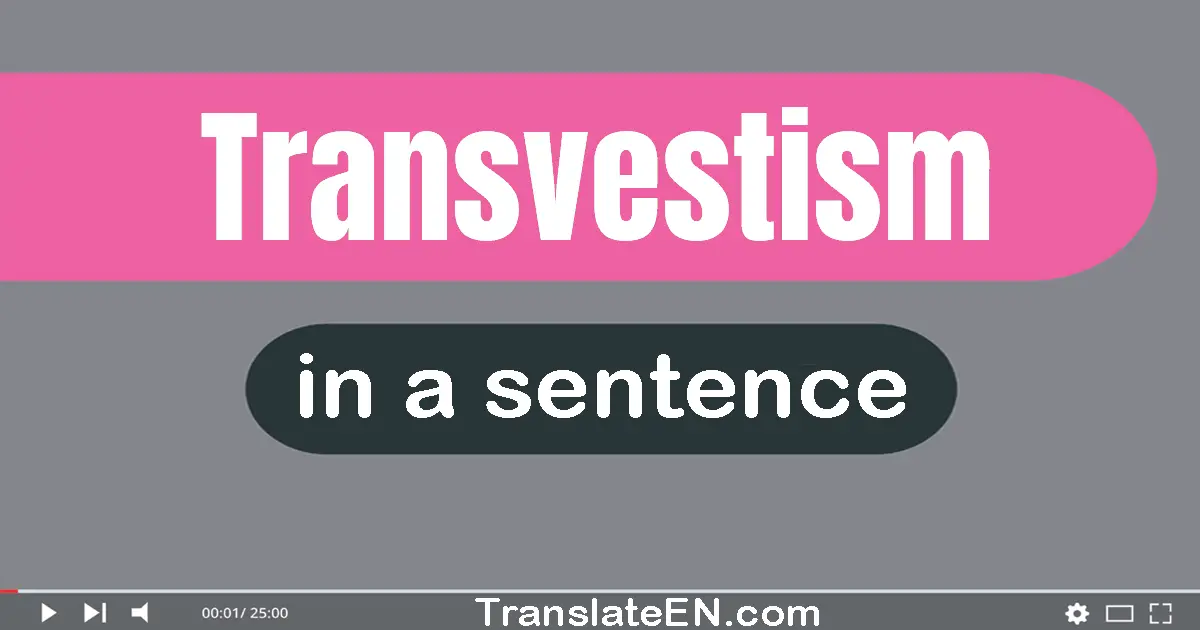Transvestism in a sentence

(1) The history of transvestism dates back centuries.
(2) Transvestism is not a mental illness or disorder.
(3) Transvestism is not synonymous with being transgender.
(4) Transvestism is a complex and multifaceted phenomenon.
(5) Transvestism is often associated with the LGBTQ+ community.
(6) Transvestism is often misunderstood and stigmatized in society.
(7) Transvestism is often misunderstood and stigmatized by society.
(8) Transvestism is protected under certain anti-discrimination laws.
(9) Transvestism is a valid and legitimate form of gender expression.
(10) Transvestism challenges traditional gender norms and expectations.
Transvestism sentence
(11) Transvestism is a beautiful and empowering form of self-expression.
(12) Some people engage in transvestism as a form of artistic expression.
(13) Transvestism is a personal journey that varies from person to person.
(14) Many individuals find empowerment and self-expression through transvestism.
(15) Transvestism can be a private and personal experience for many individuals.
(16) Transvestism can be a source of joy and liberation for those who practice it.
(17) Transvestism can be a way for individuals to challenge societal gender roles.
(18) Transvestism is a form of self-expression that should be respected and accepted.
(19) Some people who engage in transvestism may experience discrimination or harassment.
(20) Transvestism can be a way for individuals to feel more connected to their true selves.
Transvestism make sentence
(21) Transvestism can be a way for individuals to challenge societal expectations and norms.
(22) Transvestism can be a way for individuals to express their creativity and individuality.
(23) Transvestism can be a way for individuals to challenge and dismantle gender stereotypes.
(24) Many famous performers, such as drag queens, engage in transvestism as part of their act.
(25) Transvestism is not a mental disorder, despite being listed as a paraphilia in the DSM-5.
(26) Transvestism can be a way for individuals to explore different aspects of their personality.
(27) Transvestism is the act of dressing in clothing typically associated with the opposite gender.
(28) Transvestism can be a way for individuals to challenge traditional gender norms and expectations.
(29) Transvestism can be a way for individuals to feel more comfortable and confident in their own skin.
(30) The practice of transvestism has a long history, dating back to ancient cultures such as the Greeks and Romans.
Transvestism meaning
Transvestism is a term that refers to the practice of dressing and presenting oneself in clothing typically associated with the opposite gender. It is important to approach this topic with sensitivity and respect, as individuals who engage in transvestism often do so as a means of self-expression and exploring their gender identity. When using the word "transvestism" or the phrase "engage in transvestism" in a sentence, it is crucial to maintain a respectful and non-judgmental tone. Here are some tips on how to incorporate this term effectively:
1. Define the term: When introducing the word "transvestism" in a sentence, it is helpful to provide a brief definition to ensure clarity.
For example, "Transvestism, which is the act of dressing in clothing typically associated with the opposite gender, has been practiced for centuries."
2. Use inclusive language: When discussing transvestism, it is essential to use inclusive language that respects individuals' gender identities. Avoid making assumptions about someone's gender identity or using derogatory terms. For instance, "Many individuals who engage in transvestism find it to be a liberating form of self-expression."
3. Provide context: When using the phrase "engage in transvestism," it is beneficial to provide additional context to help readers understand the broader implications.
For example, "Some people engage in transvestism as a way to challenge societal norms and explore their gender identity."
4. Avoid stereotypes: It is crucial to avoid perpetuating stereotypes or misconceptions about transvestism. Instead, focus on promoting understanding and acceptance. For instance, "Transvestism is not indicative of an individual's sexual orientation, as it is solely a form of self-expression."
5. Respect privacy: When discussing transvestism, it is important to respect individuals' privacy and not disclose personal information without their consent. Always prioritize confidentiality and avoid sensationalizing or stigmatizing the topic.
6. Use appropriate pronouns: When referring to individuals who engage in transvestism, it is essential to use their preferred pronouns. If you are unsure, it is best to use gender-neutral pronouns such as they/them until you have been informed otherwise.
7. Promote acceptance and understanding: In your sentence, consider promoting acceptance and understanding of transvestism.
For example, "Society has made significant progress in accepting and understanding transvestism as a valid form of self-expression."
8. Educate yourself: To use the word "transvestism" or the phrase "engage in transvestism" effectively, it is crucial to educate yourself about the topic. Familiarize yourself with the experiences and perspectives of individuals who engage in transvestism to ensure accurate and respectful usage. Remember, using the word "transvestism" or the phrase "engage in transvestism" in a sentence should always be done with respect, sensitivity, and a commitment to promoting understanding and acceptance.
The word usage examples above have been gathered from various sources to reflect current and historical usage of the word Transvestism. They do not represent the opinions of TranslateEN.com.
